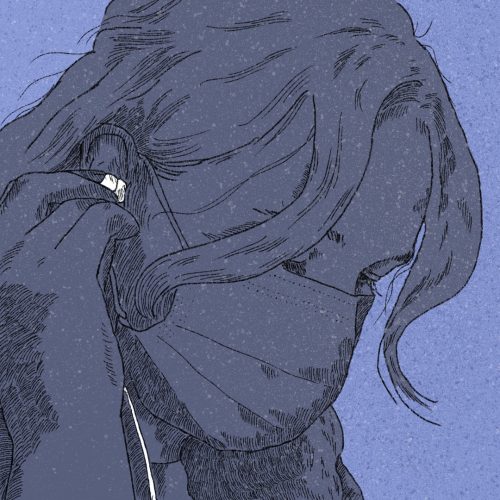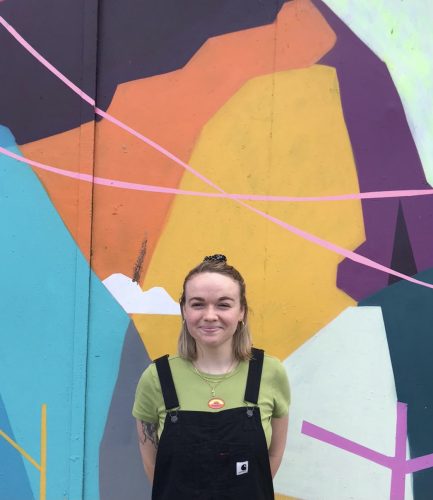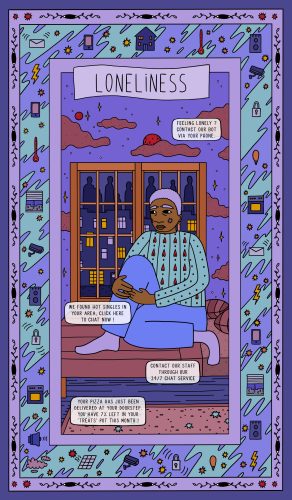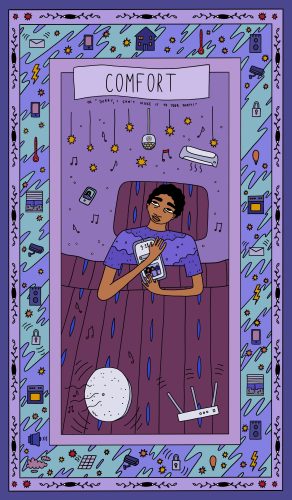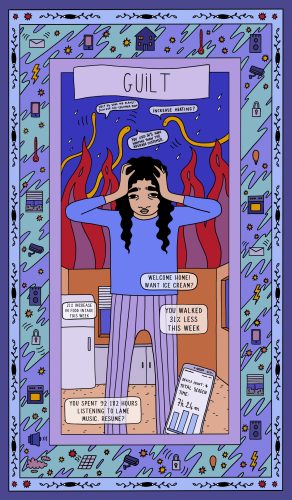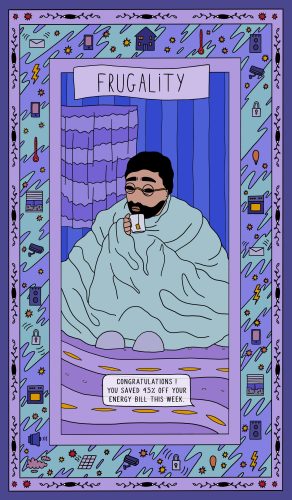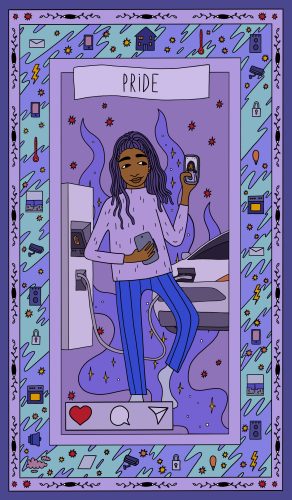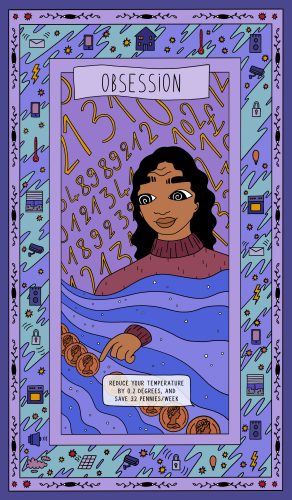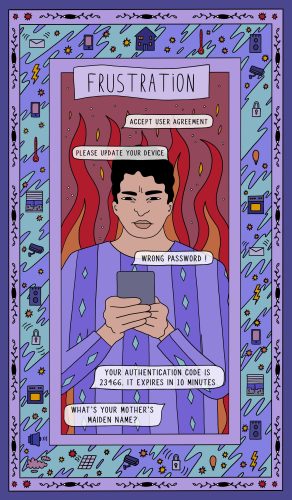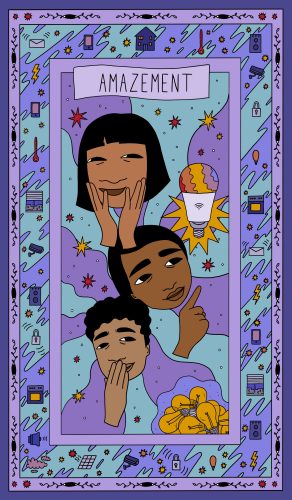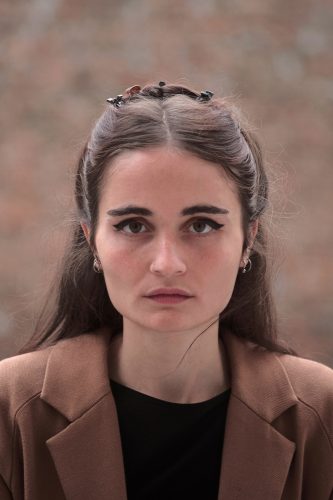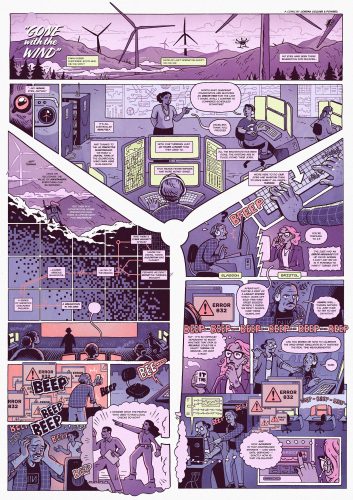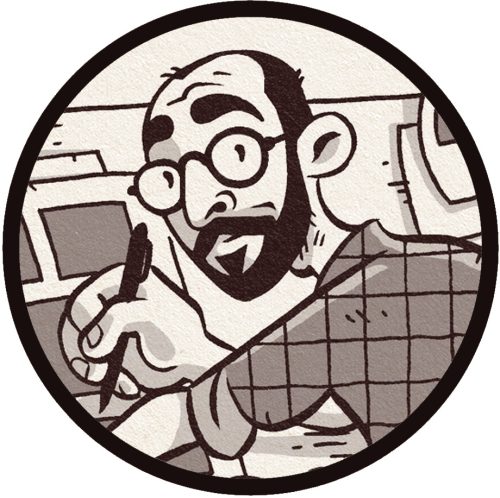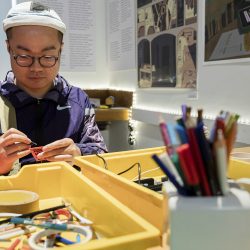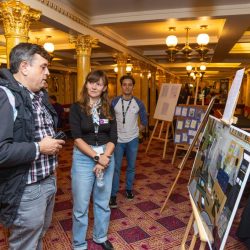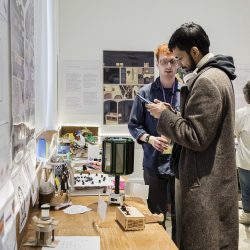Article
Electric Feels
Artistic responses to research exploring human dimensions of digital energy transformation
Energy is often invisible to us, and so are the slowly creeping changes to the infrastructure which delivers, manages and maintains our supply of it. The recent crisis of affordability and increasing need to address a fossil fuel crisis are a context in which it is perhaps necessary to stop and question how we feel about energy; to consider the possible futures we might be moving towards and the ways an increasing data-driven energy supply could change other aspects of our lives, for better and worse.
We invited four illustrators to create original artworks in response to the research of the Power2 project. Project researcher Dr Ola Michalec (University of Bristol) and PETRAS Synthesis Fellow Joe Bourne (Lancaster University) collaborated to create unique works of fiction as provocations for each artist. The works take an often speculative approach to exploring the intersection of energy, digital technology and emotions.The works invite viewers to consider:
What’s your vision for a sustainable future?
How do you feel about computers telling you how to save energy?
Have recent innovations actually improved your use and experience of energy?
How could your domestic routines and chores change as a result of future energy innovations?
Smarter Living, Lizzie Ormian
This single page comic walks us through a house and a person’s relationship with energy. Though we never see the resident we hear descriptions of energy use. “I” is ambiguous whether it is the dweller or the house and the devices within it sharing these views. This work encourages viewers to reflect on their own home routines and habits, which may have come about through no conscious design process – do you use energy the way you want to, the way they want you to, or the only way you know how to?

Lizzie Ormian (click to see the full size version)
Lizzie Ormian is an independent artist, recently graduated from Falmouth University, whose work tends to focus on using limited colours to create a strong sense of atmosphere. Her quiet yet powerful style evokes a home which is entirely believable and yet also surreal. Domestic details provide familiarity and show signs of life, yet the stillness of her restricted colour palette and stark arrangements show a house not fully lived in at all.
https://lizormianillustration.co.uk/
Control Rooms, Mary Flora Hart
With the rise of new tariffs and energy start ups, it seems like we have more options when deciding how to source, use or even generate energy at home. It is becoming increasingly possible for people to take control of the ways in which their power is sourced and managed in their homes. But are these ‘smart technologies’ designed for a certain type of ‘smart’ consumer? What is the experience of the ‘non-smart’ consumer?
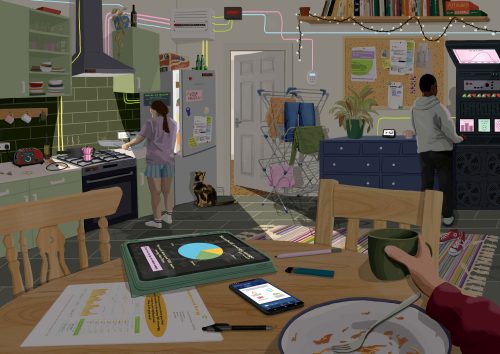
Mary Flora Hart (click to see the full size version)
Mary Flora Hart explores these questions through a huge and immersive illustration of a shared flat in a not so distant future, in which home data screens, buttons, dials and interfaces have crept into the home to such a degree over the years that our homes have started to look more like power station control rooms than living spaces. Except this is a living space. Neglected houseplants compete for attention with smart energy displays; dirty dishes obscure warning lights and the renters’ different approaches to home-labour show through in their relationships with these technologies.
Mary is a Bristol based digital illustrator. Her work covers a wide variety of themes, but she often explores environmental topics, and does this using rather chaotic scenes to create immersive single page narratives. The goal of this project was to capture the potential reality of taking energy sourcing and usage into the hands of an everyday consumer, in an everyday household. Mary’s way of working seemed to fall quite perfectly into this. The end illustration aims to represent the possibilities of a ‘Home Control Room’, but also the likely difficulties that might come with shifting control to consumers.
https://www.maryflorahart.co.uk/
Powerful Emotions, Aude Nasr
In this work, Aude Nasr explores how smart homes make us feel: The ways smart appliances work causes a wide range of emotional reactions. These fictional emotions were inspired by a review of ethnographic and interview based research with members of the public who were experiencing energy transitions.
Aude has brought these experiences to life, imagining how the emotions may manifest in future energy transitions, through eight tarot cards, each personifying different emotions captured in energy ethnographies: amazement, comfort, frustration, guilt, loneliness, pressure, thriftiness and virtuousness.
Aude Nasr (click to see the full size version)
Aude Nasr (click to see the full size version)
Aude Nasr (click to see the full size version)
Aude Nasr (click to see the full size version)
Aude Nasr (click to see the full size version)
Aude Nasr (click to see the full size version)
Aude Nasr (click to see the full size version)
Aude Nasr (click to see the full size version)
Aude Nasr (Aboul-Nasr) is a French Lebanese illustrator currently based in Marseille, France. She works with various independent media and platforms in the Middle-East and Europe, illustrating voices that thrive to give a more relevant, accurate and critical understanding of the changes operating in the region, within diasporas, and among communities she belongs to. She also creates dreamy imaginaries with various initiatives and artists from here and there, and shares her own illustrated stories along the way.
(Aude Nasr, Amer Albarzawi).
Gone with the Wind, Jordan Collver
This piece considers the digitalisation of the energy industry from the point of view of those delivering and maintaining the infrastructure. Jordan’s comic tells a non-linear story of a manager in a futuristic grid control room, decommissioning wind turbines using AI and sensor based predictive maintenance. It’s 2047 and wind turbines in rugged Scottish Highlands are controlled entirely remotely. Thanks to the AI predictive maintenance, they last longer and with less scheduled downtime. But how does AI understand the life of a wind turbine? Is the data collected from sensors accurate and secure? What happened to the local manual workers and their knowledge? And last, but not least, what happens when this goes wrong?
Jordan Collver (click to see the full size version)
Jordan Collver is an illustrator and science communicator using visual narratives in comics to explore themes of science, nature, and belief. He is the artist for the Eisner-nominated comic Hocus Pocus: Magic, Mystery & The Mind, and his work has been featured in The London Natural History Museum, The Journal of Science Communication, Slate, Physics World, Science for the People, Skeptical Inquirer, The Nib, and several comic anthologies. He sounds Canadian but lives in Bristol, UK.
https://jordancollver.myportfolio.com/work
About POWER2 research:
Power2 explores socio-technical challenges of governing IoT security in the energy industry.
IoT is expected to play a major part in the ongoing transition of energy systems. With the possibility of new actors, tariffs, appliances and relationships, IoT could disrupt the energy market – whether for the better or worse.
The notion of “disruption” should not be taken for granted – the success of smart energy initiatives relies on software developers’ assumptions as well as regulatory requirements with regards security, privacy and data sharing. What arrangements are “good enough” to make digitalisation work? What are the social implications of these arrangements? What are the regulatory gaps resulting from development of IoT? How do we facilitate development of responsible innovation where IoT is aligned with policy goals of decarbonisation, affordability and security?
This project applied theories from Science and Technology studies, expert stakeholders elicitation method,s and illustration comission to help us envision future-oriented narratives for cybersecurity governance in the energy sector. Read more about the Power2 project and find its deliverables on the project website.
Ola Michalec is a social scientist based at the University of Bristol, UK. She is interested in ‘the making of’ digital technologies for sustainability. In particular, her work concerns the politics embedded in engineering infrastructures, (cyber)security and sociology of expertise. She also leads the SPRITE+ initiative on communicating cybersecurity, inviting creative approaches to visualise, frame and discuss digital technologies.
Past Events
- Science and Technology Studies Conference, Graz, 8-10th May 2023, “Make your own control room!” Session, Register here: https://stsconf.tugraz.at/registration/
- Exhibition launch in Bristol, 9th June 2023 https://www.headfirstbristol.co.uk/#date=2023-06-09&event_id=89296
- PETRAS Showcase, London, 16th June 2023,
- SPRITE+ Conference, Belfast, 28-29th June 2023
- UK Association for Studies in Innovation, Science and Technology Conference, Manchester, 4-5th September 2023
- Digital Design Weekend at the V&A Museum, London, 22-24th September 2023
- FUTURES Festival of Discovery, Bristol, 29th September 2023
- SPRITE+ Workshop: Creative Ways of Communicating Cyber, online, 8th December 2023”
Credits to: the V&A Digital Design Weekend 2023, photos by Hydar Dewachi; FUTURES Festival of Discovery 2023, University of Bristol.
In total, we estimate that over 1300 members of the public and over 300 academics and practitioners engaged with our artworks, taking part in stimulating conversations and interactive activities.
Acknowledgements
We would like to extend our heartfelt gratitude to the individuals and organisations whose support and contributions have been instrumental in the success of our project. First and foremost,
we express our sincere appreciation to Steve Cordle, Laurence Fahrni, and Sam Young for sharing their energy expertise and ‘factchecking’ our drafts. We would like to extend our special thanks to Jordan Taylor and Alex Kavvos for their unwavering tech support throughout the project. You made us see computers in a new light. Lata Nautiyal, your exceptional web design skills have given our tarot machine a visually appealing and user-friendly presence.
Our heartfelt thanks go to the Bristol Interactions Group, (Anne Roudaut, Mike Fraser, Jarrod Knibble, Paul Worgan, and Oliver Child) for generously lending us their prototypes. Many thanks to Louise Evans and Emily Gingell, for their administrative support. You helped us to navigate the university’s maze of IT, printing and procurement systems! We would like to express our appreciation to Marc Barto and Fiona McKendrick from the V&A for their kind invitation to the event and generous support in the weeks leading up to the showcase. Finally, we would like to thank our funders, the PETRAS National Centre for Excellence in IoT Cybersecurity and Bristol Cyber Security Group, who enabled us to nurture turn our blue sky ideas into a tangible reality.


